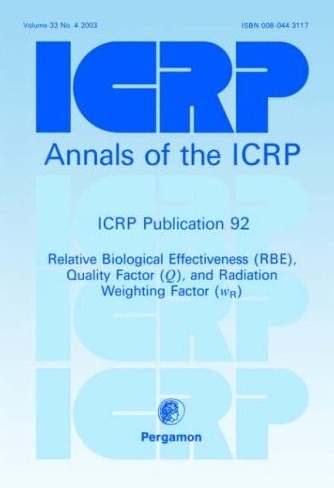ICRP Publication 92
Relative Biological Effectiveness (RBE), Quality Factor (Q), and Radiation Weighting Factor (wR)
Recommended citation
ICRP, 2003. Relative Biological Effectiveness (RBE), Quality Factor (Q), and Radiation Weighting Factor (wR). ICRP Publication 92. Ann. ICRP 33 (4).
Abstract - The effect of ionising radiation is influenced by the dose, the dose rate, and the quality of the radiation. Before 1990, dose-equivalent quantities were defined in terms of a quality factor, Q(L), that was applied to the absorbed dose at a point in order to take into account the differences in the effects of different types of radiation. In its 1990 recommendations, the ICRP introduced a modified concept. For radiological protection purposes, the absorbed dose is averaged over an organ or tissue, T, and this absorbed dose average is weighted for the radiation quality in terms of the radiation weighting factor, wR, for the type and energy of radiation incident on the body. The resulting weighted dose is designated as the organ- or tissue-equivalent dose, HT. The sum of the organ-equivalent doses weighted by the ICRP organ-weighting factors, wT, is termed the effective dose, E. Measurements can be performed in terms of the operational quantities, ambient dose equivalent, and personal dose equivalent. These quantities continue to be defined in terms of the absorbed dose at the reference point weighted by Q(L).
The values for wR and Q(L) in the 1990 recommendations were based on a review of the biological and other information available, but the underlying relative biological effectiveness (RBE) values and the choice of wR values were not elaborated in detail. Since 1990, there have been substantial developments in biological and dosimetric knowledge that justify a reappraisal of wR values and how they may be derived.
This re-appraisal is the principal objective of the present report. The report discusses in some detail the values of RBE with regard to stochastic effects, which are central to the selection of wR and Q(L). Those factors and the dose-equivalent quantities are restricted to the dose range of interest to radiation protection, i.e. to the general magnitude of the dose limits. In special circumstances where one deals with higher doses that can cause deterministic effects, the relevant RBE values are applied to obtain a weighted dose. The question of RBE values for deterministic effects and how they should be used is also treated in the report, but it is an issue that will demand further investigations.
This report is one of a set of documents being developed by ICRP Committees in order to advise the ICRP on the formulation of its next Recommendations for Radiological Protection. Thus, while the report suggests some future modifications, the wR values given in the 1990 recommendations are still valid at this time. The report provides a scientific background and suggests how the ICRP might proceed with the derivation of wR values ahead of its forthcoming recommendations.
ICRP, 2003. Relative Biological Effectiveness (RBE), Quality Factor (Q), and Radiation Weighting Factor (wR). ICRP Publication 92. Ann. ICRP 33 (4).
Abstract - The effect of ionising radiation is influenced by the dose, the dose rate, and the quality of the radiation. Before 1990, dose-equivalent quantities were defined in terms of a quality factor, Q(L), that was applied to the absorbed dose at a point in order to take into account the differences in the effects of different types of radiation. In its 1990 recommendations, the ICRP introduced a modified concept. For radiological protection purposes, the absorbed dose is averaged over an organ or tissue, T, and this absorbed dose average is weighted for the radiation quality in terms of the radiation weighting factor, wR, for the type and energy of radiation incident on the body. The resulting weighted dose is designated as the organ- or tissue-equivalent dose, HT. The sum of the organ-equivalent doses weighted by the ICRP organ-weighting factors, wT, is termed the effective dose, E. Measurements can be performed in terms of the operational quantities, ambient dose equivalent, and personal dose equivalent. These quantities continue to be defined in terms of the absorbed dose at the reference point weighted by Q(L).
The values for wR and Q(L) in the 1990 recommendations were based on a review of the biological and other information available, but the underlying relative biological effectiveness (RBE) values and the choice of wR values were not elaborated in detail. Since 1990, there have been substantial developments in biological and dosimetric knowledge that justify a reappraisal of wR values and how they may be derived.
This re-appraisal is the principal objective of the present report. The report discusses in some detail the values of RBE with regard to stochastic effects, which are central to the selection of wR and Q(L). Those factors and the dose-equivalent quantities are restricted to the dose range of interest to radiation protection, i.e. to the general magnitude of the dose limits. In special circumstances where one deals with higher doses that can cause deterministic effects, the relevant RBE values are applied to obtain a weighted dose. The question of RBE values for deterministic effects and how they should be used is also treated in the report, but it is an issue that will demand further investigations.
This report is one of a set of documents being developed by ICRP Committees in order to advise the ICRP on the formulation of its next Recommendations for Radiological Protection. Thus, while the report suggests some future modifications, the wR values given in the 1990 recommendations are still valid at this time. The report provides a scientific background and suggests how the ICRP might proceed with the derivation of wR values ahead of its forthcoming recommendations.
